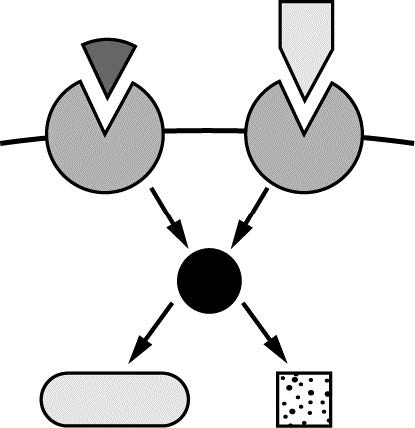unit 4 mcq exam
1/19
Name | Mastery | Learn | Test | Matching | Spaced |
|---|
No study sessions yet.
20 Terms
The diagram above illustrates feedback control as exerted by the hormone thyroxine. Following surgical removal of the thyroid gland, the level of TSH in the blood will increase. Which of the following best explains this increase? q
A decrease in thyroxine levels means a loss of inhibition to the hypothalamus and anterior pituitary, leading to increased TSH secretion.
What is the expected percent change in the DNA content of a typical eukaryotic cell as it progresses through the cell cycle from the start of the G1 phase to the end of the G2 phase?
+100%
Cortisol is a hormone produced in response to stress, including starvation in humans. Which of the following is most likely an immediate effect of a starvation-induced increase in cortisol secretion?
Increased mobilization of fatty acids from fat cells
Damaged tissue releases chemicals that activate platelets and stimulate the formation of blood clots. Which of the following predictions about the activity of platelets best describes a positive feedback mechanism?
Activated platelets release chemicals that activate more platelets
DNA replication occurs
During the S phase of the cell cycle
Cancer can result from a variety of different mutational events. Which of the following is least likely to result in the initiation of a cancerous tumor?
a defect in a cell cycle checkpoint prevent a cell from entering the S phase
Most cells that have become transformed into cancer cells have which of the following characteristics when compared to normal healthy cells?
Shorter cell cycle
Cancer cells behave differently than normal body cells. For example, they ignore signals that tell them to stop dividing. Which of the following conditions will most likely cause a normal body cell to become a cancer cell?
the environment contains mutagens that induce mutations that affect cell cycle regulator proteins
Which of the following statements best describes how a growth factor stimulates cell division from outside a cell?
The growth factor binds to receptors on the cell surface, initiating a signal transduction pathway that activates specific target genes.
Which of the following best describes the role of mitosis in the cell cycle?
Distributing replicated chromosomes to daughter nuclei
The cell cycle of yeast cells grown in the nutrient-poor environment is approximately what percent of the cell cycle of yeast cells grown in the nutrient-rich environment?
168
Which of the following is true of mitosis?
it maintains the same chromosome number in the daughter cells as in the parent cell
The vertebrate forelimb initially develops in the embryo as a solid mass of tissue. As development progresses, the solid mass near the end of the forelimb is remodeled into individual digits. Which of the following best explains the role of apoptosis in remodeling the forelimb?
Apoptosis involves the regulated activation of proteins in specific cells of the developing forelimb that leads to the death of those cells
If the calcium in your blood decreases below homeostasis levels, a gland in the brain will sense the decrease and send a chemical message to your bones. Your bones will release calcium into the blood, bringing blood calcium levels back up. This is an example of what type of feedback?
Negative Feedback Loop
The figure below shows a model of ligand precursor being cleaved to produce an active ligand that binds to a specific receptor. Which of the following is mostly likely to reduce the binding of the active ligand to its receptor?
A mutation in the receptor gene that causes a substitution of a changed amino acid for a nonpolar amino acid in the ligand binding site of the receptor
Based on the model of eukaryotic cell cycle regulation shown in the figure, which of the following best describes the effect of a drug that blocks the production of the mitotic cyclin?
The cell would be prevented from entering mitosis, and the cell would stop dividing
A researcher is conducting an experiment in which cells in different phases of the cell cycle are fused together. The researcher then records what happens to the nuclei of the resulting cell (Table 1).
TABLE 1. COMBINATIONS OF CELLS THAT WERE FUSED AND THE PHASE OF NUCLEI IN THE RESULTING CELL
Which of the following research questions is best addressed by the experiment?
How do chemical messengers affect a cell's transition between the phases of the cell cycle?
Which of the following describes a mutation that would lead to an increase in the frequency of nondisjunction?
A mutation affecting checkpoint 3 proteins that prevents attachment of spindle fibers
Based on Figure 1, what percent of the time required to complete a full cycle do the cells typically spend in interphase?
95%
Which of the following best represents two different signaling pathways that share a second messenger?
